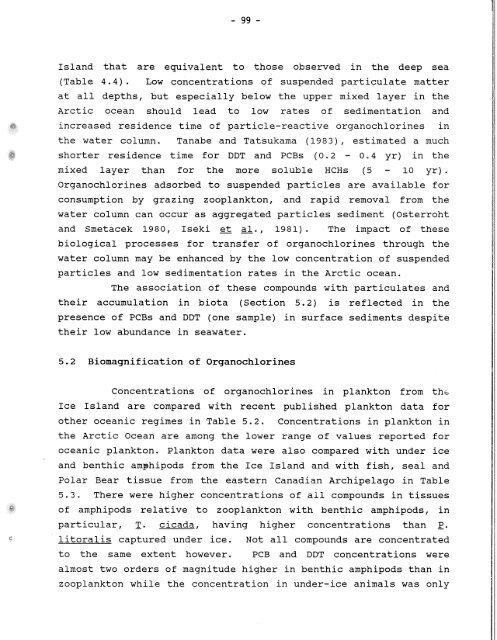Distribution of Chlorinated Hydrocarbon Pesticides and PCBs in the ...
Distribution of Chlorinated Hydrocarbon Pesticides and PCBs in the ...
Distribution of Chlorinated Hydrocarbon Pesticides and PCBs in the ...
Create successful ePaper yourself
Turn your PDF publications into a flip-book with our unique Google optimized e-Paper software.
Isl<strong>and</strong> that are equivalent to those obsesved <strong>in</strong> <strong>the</strong> deep sea<br />
(Table 4.4). Low concentrations <strong>of</strong> suspended particulate matter<br />
at all depths, but especially below <strong>the</strong> upper mixed layer <strong>in</strong> <strong>the</strong><br />
Arctic ocean should lead to low rates <strong>of</strong> sedimentation <strong>and</strong><br />
<strong>in</strong>creased residence time <strong>of</strong> particle-reactive srganochlor<strong>in</strong>es <strong>in</strong><br />
<strong>the</strong> water column. Tanabe <strong>and</strong> Tatsukama (1983), estimated a much<br />
shorter residence time for DDT <strong>and</strong> <strong>PCBs</strong> (0.2 - 0.4 yr) <strong>in</strong> <strong>the</strong><br />
mixed layer than for <strong>the</strong> more soluble HCHs (5 - 10 yr).<br />
Organochlor<strong>in</strong>es adsorbed to suspended particles are available for<br />
consumption by graz<strong>in</strong>g zooplankton, <strong>and</strong> rapid removal from <strong>the</strong><br />
water column can occur as aggregated particles sediment (Osterroht<br />
<strong>and</strong> Smetacek 1980, Iseki & d., 1981). The impact <strong>of</strong> <strong>the</strong>se<br />
biological processes for transfer <strong>of</strong> organochlor<strong>in</strong>es through <strong>the</strong><br />
water column may be enhanced by <strong>the</strong> low concentration <strong>of</strong> suspended<br />
particles <strong>and</strong> low sedimentation rates <strong>in</strong> <strong>the</strong> Arctic ocean.<br />
The association <strong>of</strong> <strong>the</strong>se compounds with particulates <strong>and</strong><br />
<strong>the</strong>ir accumulation <strong>in</strong> biota (Section 5.2) is reflected <strong>in</strong> <strong>the</strong><br />
presence <strong>of</strong> <strong>PCBs</strong> <strong>and</strong> DDT (one sample) <strong>in</strong> surface sediments despite<br />
<strong>the</strong>ir low abundance <strong>in</strong> seawater.<br />
5.2 Biomagnification <strong>of</strong> Organochlor<strong>in</strong>es<br />
Concentrations <strong>of</strong> organochlor<strong>in</strong>es <strong>in</strong> plankton from <strong>the</strong><br />
Ice Isl<strong>and</strong> are compared with recent published plankton data for<br />
o<strong>the</strong>r oceanic regimes <strong>in</strong> Table 5.2. Concentrations <strong>in</strong> plankton <strong>in</strong><br />
<strong>the</strong> Arctic Ocean are among <strong>the</strong> lower range <strong>of</strong> values reported for<br />
oceanic plankton. Plankton data were also compared with under ice<br />
<strong>and</strong> benthic amphipods from <strong>the</strong> Ice Isl<strong>and</strong> <strong>and</strong> with fish, seal <strong>and</strong><br />
Polar Bear tissue from <strong>the</strong> eastern Canadian Archipelago <strong>in</strong> Table<br />
5.3. There were higher concentrations <strong>of</strong> all compounds <strong>in</strong> tissues<br />
<strong>of</strong> amphipods relative to zooplankton with benthic amphipods, <strong>in</strong><br />
particular, 2. cicada, hav<strong>in</strong>g higher concentrations than g.<br />
Pitoralis captured under ice. Not all compounds are concentrated<br />
to <strong>the</strong> same extent however. PCB <strong>and</strong> DDT concentrations were<br />
almost two orders <strong>of</strong> magnitude higher <strong>in</strong> benthic amphipods than <strong>in</strong><br />
zooplankton while <strong>the</strong> concentration <strong>in</strong> under-ice animals was only

















